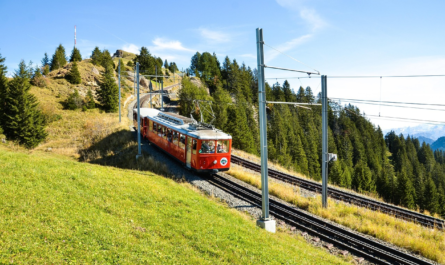Adopting sustainable travel practices can help ensure that future generations can continue to enjoy this natural wonder. In this article, we explore eco-friendly travel tips to help you visit Mount Rigi while minimizing your environmental impact.
1. Choosing Sustainable Transportation
a. Opt for Public Transport
Switzerland’s well-connected and efficient public transport system makes it easy to reach Mount Rigi without relying on private cars. Consider taking a train to Arth-Goldau or Vitznau, followed by the Rigi Bahnen, the first mountain railway in Europe, which operates using sustainable energy sources.
b. Take the Cogwheel Train or Cable Car
The Rigi Bahnen cogwheel train and cable car run on hydroelectric power, making them an eco-friendly alternative to driving. These scenic rides not only reduce carbon emissions but also enhance your travel experience with stunning views of the Swiss landscape.
c. Consider Biking or Hiking
For the adventurous traveler, cycling or hiking up Mount Rigi is an excellent way to reduce carbon emissions while staying active. Various hiking trails and cycling routes cater to different fitness levels, allowing you to immerse yourself in nature responsibly.
2. Supporting Sustainable Accommodation
a. Choose Eco-Friendly Hotels
Look for accommodations that prioritize sustainability. Many hotels near Mount Rigi use renewable energy, implement waste reduction policies, and promote eco-friendly practices. Websites like Green Key and EcoHotels.com can help you find sustainable lodging options.
b. Stay in Local Guesthouses
Opting for small, locally owned guesthouses supports the local economy while reducing the environmental footprint associated with large hotel chains. These accommodations often incorporate sustainable practices like using local ingredients for meals and minimizing waste.
3. Practicing Responsible Tourism
a. Follow Leave No Trace Principles
When hiking or exploring Mount Rigi, adhere to the Leave No Trace principles:
- Carry out all waste, including biodegradable materials.
- Stay on marked trails to prevent soil erosion.
- Avoid picking plants or disturbing wildlife.
b. Reduce Plastic Waste
- Carry a reusable water bottle to avoid buying single-use plastic bottles.
- Use eco-friendly packaging for snacks and meals.
- Bring a reusable shopping bag for souvenirs.
c. Respect Local Wildlife
Wildlife plays a crucial role in maintaining Mount Rigi’s ecosystem. Avoid feeding animals, making loud noises, or venturing into restricted areas. Keeping a respectful distance ensures that natural habitats remain undisturbed.
4. Eating Sustainably
a. Dine at Restaurants Using Local Ingredients
Choose restaurants that source ingredients from local farms and prioritize organic and seasonal produce. This not only reduces the carbon footprint but also supports local businesses.
b. Reduce Food Waste
Order only what you can eat, and consider bringing a reusable container for leftovers. Many Swiss eateries offer portion-controlled meals to minimize food waste.
c. Opt for Plant-Based Meals
Plant-based diets have a lower environmental impact than meat-heavy meals. While visiting Mount Rigi, try traditional Swiss vegetarian dishes such as Rösti, Älplermagronen, or fondue made with locally sourced cheese.
5. Engaging in Eco-Friendly Activities
a. Explore by Foot
Hiking is one of the best ways to appreciate Mount Rigi’s natural beauty while minimizing environmental impact. There are numerous trails suitable for all levels, from easy walks to challenging hikes.
b. Participate in Nature Conservation Programs
Some organizations offer volunteer programs for visitors interested in contributing to environmental conservation. Activities may include tree planting, trail maintenance, or wildlife monitoring.
c. Choose Low-Impact Recreational Activities
Rather than engaging in motorized sports, consider activities that have a lower environmental footprint, such as:
- Birdwatching
- Photography
- Yoga retreats in nature
6. Offsetting Your Carbon Footprint
a. Support Carbon Offset Programs
If you must travel by air or drive part of the way, consider offsetting your carbon footprint by donating to certified programs that fund renewable energy projects or forest conservation efforts.
b. Travel During Off-Peak Seasons
Visiting Mount Rigi during the off-peak season (spring and autumn) reduces the strain on local infrastructure and minimizes the environmental impact of over-tourism.
c. Extend Your Stay
Instead of making multiple short trips, consider staying longer. This reduces the frequency of travel-related emissions while allowing you to explore the region more deeply.
Sustainable Travel to Mount Rigi: A Responsible Visitor’s Guide
Traveling sustainably to Mount Rigi ensures that you can enjoy its breathtaking scenery while minimizing your environmental footprint. One of the most effective ways to do this is by choosing eco-friendly transportation. Switzerland’s extensive public transport network allows visitors to reach Mount Rigi efficiently without relying on private cars. A train ride to Arth-Goldau or Vitznau, followed by the historic Rigi Bahnen cogwheel train—powered by hydroelectric energy—offers a scenic and sustainable alternative. Similarly, taking a cable car instead of driving not only reduces emissions but also provides spectacular panoramic views of the Swiss Alps. For the more adventurous traveler, biking or hiking up the mountain presents an excellent opportunity to stay active while embracing an environmentally responsible mode of transport.
Beyond transportation, selecting sustainable accommodation plays a crucial role in minimizing your environmental impact. Eco-friendly hotels near Mount Rigi prioritize renewable energy, waste reduction, and water conservation. Platforms like Green Key and EcoHotels.com make it easier to find lodging options that align with these values. Alternatively, staying in locally owned guesthouses supports small businesses while often providing a more authentic and sustainable travel experience. Many of these accommodations use locally sourced ingredients for meals and implement eco-conscious practices such as composting and plastic reduction.
While exploring Mount Rigi, it is essential to practice responsible tourism by adhering to Leave No Trace principles. Visitors should carry out all waste, including biodegradable materials, to maintain the mountain’s pristine beauty. Sticking to marked trails prevents soil erosion, and refraining from picking plants or disturbing wildlife helps preserve the delicate ecosystem. Reducing plastic waste is another important step—carrying a reusable water bottle, using eco-friendly food containers, and bringing a reusable shopping bag can significantly cut down on single-use plastics. Additionally, respecting local wildlife by maintaining a safe distance and avoiding disruptive behavior ensures that natural habitats remain undisturbed.
Sustainable dining choices can further enhance eco-friendly travel experiences. Choosing restaurants that source ingredients from local farms supports regional agriculture while reducing food miles. Many Swiss eateries offer portion-controlled meals, which help combat food waste, and bringing a reusable container for leftovers is another simple yet effective practice. Opting for plant-based meals, such as traditional Swiss vegetarian dishes like Rösti or Älplermagronen, can also reduce the environmental impact of dining. These meals not only support sustainability efforts but also allow visitors to experience authentic Swiss cuisine.
Engaging in low-impact activities is another way to contribute to Mount Rigi’s preservation. Hiking remains the best way to appreciate the mountain’s landscapes without harming the environment. For those looking to give back, conservation programs offer opportunities to participate in activities like tree planting, trail maintenance, and wildlife monitoring. Other eco-friendly recreational options, such as birdwatching, photography, and outdoor yoga, allow visitors to connect with nature in a responsible manner. By choosing these activities over motorized sports, travelers can enjoy Mount Rigi while minimizing their carbon footprint.
Finally, carbon offsetting can help mitigate the environmental impact of necessary travel. Supporting carbon offset programs that fund renewable energy projects or forest conservation initiatives can balance emissions from flights or car journeys. Additionally, visiting Mount Rigi during off-peak seasons—such as spring or autumn—reduces the strain on local infrastructure while allowing for a more peaceful travel experience. Extending your stay instead of making multiple short trips also helps reduce overall travel emissions while providing an opportunity to explore the region more thoroughly.
By making thoughtful choices in transportation, accommodation, tourism practices, dining, and activities, visitors can enjoy Mount Rigi in a way that preserves its natural beauty for future generations. Sustainable travel not only benefits the environment but also enhances the overall experience, making it more immersive, authentic, and rewarding.
Mount Rigi’s natural beauty and ecological significance make it a destination worth preserving. By adopting sustainable travel practices—such as using public transport, supporting eco-friendly accommodations, practicing responsible tourism, and reducing waste—you can enjoy a fulfilling and environmentally conscious visit. Whether hiking its scenic trails, savoring local delicacies, or engaging in conservation efforts, every small action contributes to protecting this Swiss treasure for generations to come.



